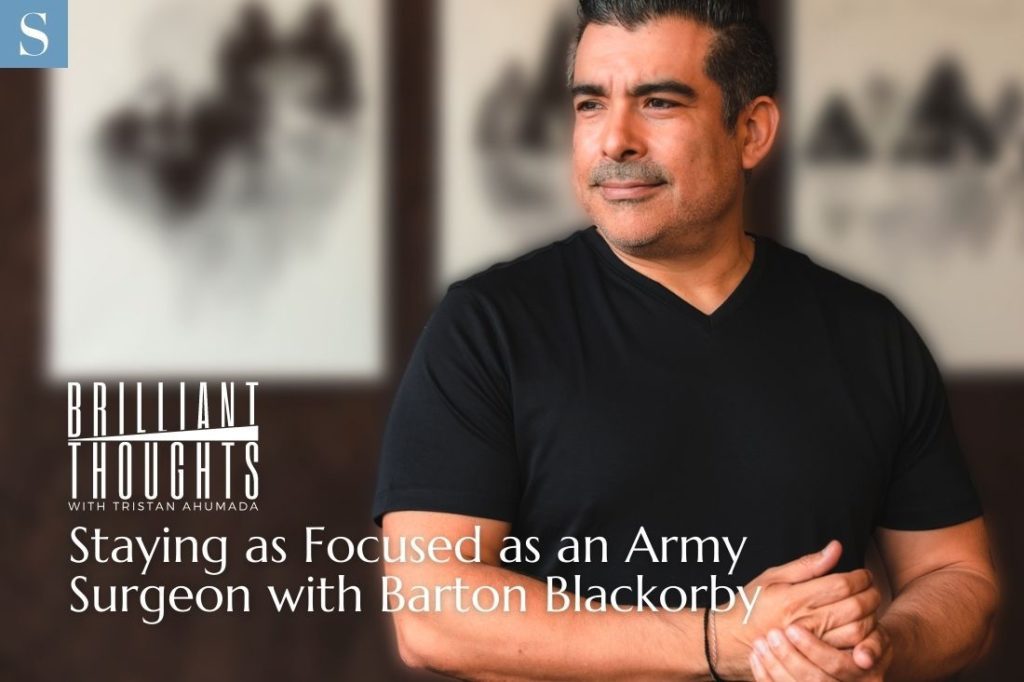Few life events are more stressful than going to war. Some military personnel fight through the worst trauma imaginable, such as gruesome combat, extreme fatigue, and the sadness (or guilt) of losing a comrade.
Entrepreneurs and business leaders can learn a lot from veterans and active members in the military. These are people who, despite every challenge, become extraordinary leaders as a means of survival.
In this episode of Brilliant Thoughts, Dr. Barton Blackorby talks to SUCCESS People Editor Tristan Ahumada about the building blocks of leadership. Blackorby is a vitreoretinal surgeon in the U.S. army, which means he works to restore and enhance vision in his patients. He’s gone as far as Iraq, deep inside of war zones, to develop his practice and help people in need.
But of course, you don’t go to war without picking up some life-changing skills. If you’re on the path to leadership, here are Blackorby’s top tips for guiding others.
Humanize your team.
As a leader, it’s easy to go all-in on the objectives you want to tackle. You start to see every part of your operation as pieces on a chessboard, and that distances you from the human element of teamwork. But in reality, returning to a place of empathy and mutual understanding is the key to achieving group goals—especially in tough times.
That’s why Blackorby spent his free time getting to know his unit. He knew that if he built a rapport with this team before the chaos of war, individual members would have a strong foundation for success.
Blackorby’s strategy required two things: negotiation and peace-making. For example, instead of summoning team members to his office for conversations, he came to see them. Meeting people on their turf shifted the power away from him (the leader) to those with less influence (the subordinates).
Once Blackorby had the right conditions for peace, he started negotiating. He knew that most people had a perceived roadblock—either real or imaginary—stopping them from doing their best work. So he listened to the other side to understand their plight. Then he asked himself, What can I do to alleviate some of that stress?
These techniques work for entrepreneurs and business leaders, too; in fact, they extend to every part of an operation.
“[For example], who is going to be more successful at closing a deal?” Blackorby asks. “The person who sees the other party as an object or obstacle, or the person who sees others as people and actually cares about their concerns?”
Don’t catastrophize.
In Iraq, violent attacks happened quickly, Blackborby says. The doctors in his unit wore pagers, and when they sounded, everyone knew it was time to prepare for trauma.
It’s easy to panic in a situation like that, but a large part of success is learning to keep a cool head.
Here’s what the army teaches military personnel about dealing with stress:
- Acknowledge the worst-case scenario. Once you know the most catastrophic outcomes, develop ways to mitigate those risks.
- Acknowledge the most common or likely scenario. This exercise cleanses your mind of the worst-case scenario and refocuses it on the problem at hand.
“For example, if I had a surgery that didn’t go well, the most common example would be that the patient is probably going to be fine,” Blackorby says. “Most things are correctable as long as I keep my head in the game and do the right steps and post-operative care. I still need to be aware of those other things, but if I focus on them, it can almost paralyze me in the operating room because I think, ‘Oh my gosh, I may have completely blinded this patient.’ And that’s not the right mindstate to be in.”
You can also think of this as compartmentalizing. A stressful event will prompt all sorts of negative thoughts, but you can reign them in by staying present and focusing on the now.
Breathe.
It’s hard to solve a problem when your mind is in overdrive. To help personnel face that challenge, the military teaches a breathing technique called Wim Hof. It helps reduce anxiety so the brain can do its best thinking.
Here are the steps:
- Take deep, vigorous breaths for 25 seconds (as if you’re hyperventilating).
- Exhale most of the air in your lungs.
- Hold your breath for as long as you can.
- Repeat.
“What you’ve done is super-saturated your body with oxygen so you don’t have to breathe right away,” Blackorby says. “And it gives you these opportunities to mentally tell your body and your mind, ‘It’s OK. Let’s calm down. Let’s get these feelings under control.’”
Wim Hof can prepare you for various situations, including conflict resolution. If emotions are flying high between you and your team, for example, it’s hard to identify the root of a problem. On the flip side, imagine what you could accomplish with an anxiety-free brain.
You would eventually be clear enough to do two things:
- Develop insight. In what ways did you contribute to the problem, even if your role accounts for a tiny percentage?
- Remember when others gave you grace. Think of a time when you made a mistake, but someone asked, “What’s wrong?” instead of shouting at you. Can you do the same thing to de-escalate your current conflict?
No one becomes a leader overnight. It’s a high-level skill that takes years of learning (and unlearning) as you discover what authentic leadership looks like. But along the way, learning to master your emotions and resolve conflict will move you closer to your goals.
Brilliant Thoughts with Tristan Ahumada is no longer releasing new episodes on the SUCCESS Podcast Network, but you can still listen to the full conversation below.





